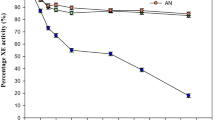Abstract
Eighteen strains of xylariaceous fungi have been screened for higher activities of cellulolytic enzymes,Trichoderma reesei QM 9414 was also examined for comparison. Strains ofXylaria anisopleura andX. regalis had higher endocellulase (CMCase) and exocellulase (Avicelase) activities after 2 weeks' incubation.Hypoxylon stygium produced the highest activity of β-glucosidase 3 days after inoculation. The optimum pH for these cellulolytic enzymes was approx. 5.0 and the optimum temperatures ranged from 37 to 50°C. A mixed culture process usingT. reesei QM 9414 andH. stygium was developed to obtain enhanced synthesis of cellulase. β-Glucosidase activities in the mixed culture increased within 48h whenH. stygium was introduced after 24h.
Similar content being viewed by others
References
Beldman, G., Voragen, A.G.J., Rombouts, F.M. & Pilnik, W. 1988 Synergism in cellulose hydrolysis by endoglucanases and exoglucanases purified fromTrichoderma viride.Biotechnology and Bioengineering31, 173–178.
Bergmeyer, H.U. 1984 Determination of ‘reducing sugars’ in the cellulose hydrolysate. InMethods of Enzymatic Analysis, 3rd edn, eds Bergmeyer, H.U., Bergmeyer, J. & Grabl, M., pp. 26–29. Weinheim: Verlag Chemie.
Bisaria, V.S. & Ghose, T.K. 1981 Biodegradation of cellulosic materials: substrates, microorganisms, enzymes and products.Enzyme Microbiology and Technology3, 90–104.
Coutts, A.D. & Smith, R.E. 1976 Factors influencing the production of cellulases bySporotrichum thermophile, Applied and Environmental Microbiology31, 819–825.
Ghose, T.K., Panda, T. & Bisaria, V.S. 1985 Effect of culture phasing and mannanase on production of cellulase and hemicellulase by mixed culture ofTrichoderma reesei D1-6 andAspergillus wentii Pt 2804.Biotechnology and Bioengineering27, 1353–1361.
Hakansson, ULF., Fägerstam, L.G. Pettersson, L.G. & Andersson, L. 1979 A 1,4-β-glucan glucanohydrolase from the cellulolytic fungusTrichoderma viride QM 9414.Biochemical Journal179, 141–149.
Halliwell, G. & Lovelady, J. 1981 Utilization of carboxymethyl-cellulose and enzyme synthesis byTrichoderma koningii.Journal of General Microbiology126, 211–217.
Johnson, E.A., Sakajoh, M., Halliwell, G., Madia, A. & Demain, A.L. 1982 Saccarification of complex cellulosic substrates by the cellulase system fromClostridium thermocellum.Applied and Environmental Microbiology43, 1125–1132.
Ju, Y.M. & Tzean, S.S. 1985a Investigations of Xylariaceae in Taiwan 1. The teleomorph ofHypoxylon, Transactions of the Mycological Society of Republic of China1, 13–27.
Ju, Y.M. & Tzean, S.S. 1985b Investigations of Xylariaceae in Taiwan II. The teleomorph ofXylaria.Transactions of The Mycological Society of Republic of China1, 103–128.
Kluepfel, D., Shareck, F., Mondou, F. & Morosoli, R. 1986 Characterization of cellulase and xylanase activities ofStreptomyces lividans.Applied Microbiology and Biotechnology24, 230–234.
Lamed, R., Bayer, E.A., Saha, B.C. & Zeikus, J.G. 1988 Biotechnological potential of enzymes from unique thermophiles. Proceedings 8th International Biotechnology Symposium, Paris, pp. 371–383.
Mandels, M. 1975 Microbial sources of cellulases. InCellulase As A chemical And Energy Resource, ed Wilke, C.R., pp. 81–105. New York: John Wiley & Sons.
Rodionova, N.A., Tavobilov, I.M., Martinovich, L.I., Buachidze, T. Sh., Kvesitadze, G.I. & Bezborodov, A.M. 1987. β-Glucosidases from cellulolytic fungiAspergillus terreus, Geotrichum candidum, andTrichoderma longibrachiatum as typical glycosidases.Biotechnology and Applied Biochemistry9, 239–250.
Roger, J.D. 1979 The Xylariaceae: Systematic, biological and evolutionary aspects.Mycologia71, 1–42.
Shigo, A.L. 1964 Organism interactions in the beech bark disease.Phytopathology54, 263–269.
Shinmyo, A., Garcia-Martinez, D.V. & Demain, A.L. 1979 Studies on the extracellular cellulolytic enzyme complex produced byClostridium thermocellum.Journal of Applied Biochemistry1, 202–209.
Wachinger, G., Bronnenmeier, K., Staudenbauer, W.L. & Schrempf, H. 1989 Identification of mycelium-associated cellulase fromStreptomyces reticuli.Applied and Environmental Microbiology55, 2653–2657.
Wood, T.M. 1985 Properties of cellulolytic enzyme systems.Biochemical Society Transactions13, 407–410.
Wood, T.M. & McCrae, S.I. 1982 Purification and some properties of a 1,4-β-glucan glucanohydrolase associated with the cellulase from the fungusPenicillium funiculosum. Carbohydrate Research110, 291–303.
Author information
Authors and Affiliations
Rights and permissions
About this article
Cite this article
Wei, D.L., Chang, S.C., Wei, Y.H. et al. Production of cellulolytic enzymes from theXylaria andHypoxylon species of xylariaceae. World J Microbiol Biotechnol 8, 141–146 (1992). https://doi.org/10.1007/BF01195834
Received:
Accepted:
Published:
Issue Date:
DOI: https://doi.org/10.1007/BF01195834




